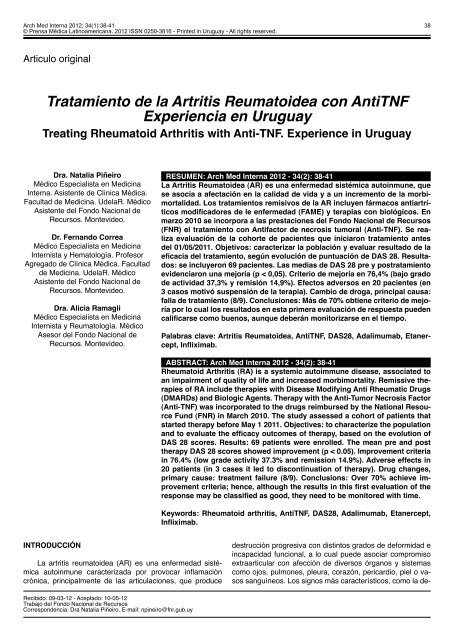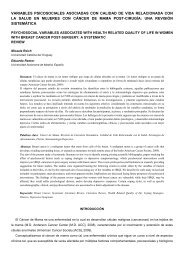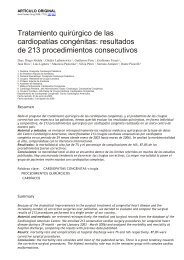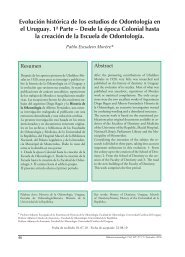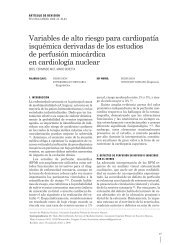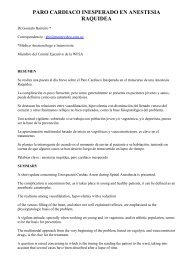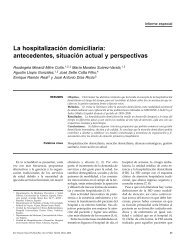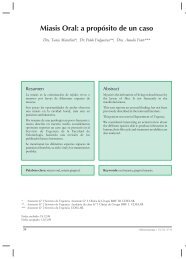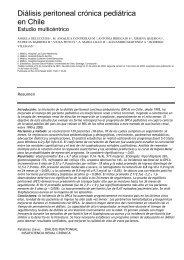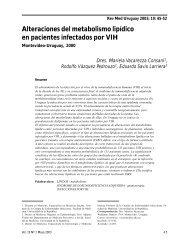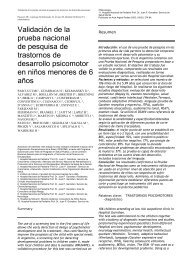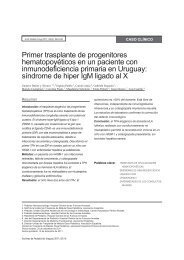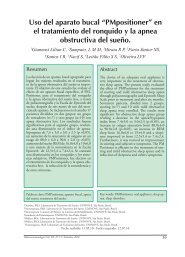Tratamiento de la Artritis Reumatoidea con AntiTNF ... - SciELO
Tratamiento de la Artritis Reumatoidea con AntiTNF ... - SciELO
Tratamiento de la Artritis Reumatoidea con AntiTNF ... - SciELO
You also want an ePaper? Increase the reach of your titles
YUMPU automatically turns print PDFs into web optimized ePapers that Google loves.
Arch Med Interna 2012; 34(1):38-41<br />
© Prensa Médica Latinoamericana. 2012 ISSN 0250-3816 - Printed in Uruguay - All rights reserved.<br />
38<br />
Articulo original<br />
<strong>Tratamiento</strong> <strong>de</strong> <strong>la</strong> <strong>Artritis</strong> Reumatoi<strong>de</strong>a <strong>con</strong> <strong>AntiTNF</strong><br />
Experiencia en Uruguay<br />
Treating Rheumatoid Arthritis with Anti-TNF. Experience in Uruguay<br />
Dra. Natalia Piñeiro<br />
Médico Especialista en Medicina<br />
Interna. Asistente <strong>de</strong> Clínica Médica.<br />
Facultad <strong>de</strong> Medicina. U<strong>de</strong><strong>la</strong>R. Médico<br />
Asistente <strong>de</strong>l Fondo Nacional <strong>de</strong><br />
Recursos. Montevi<strong>de</strong>o.<br />
Dr. Fernando Correa<br />
Médico Especialista en Medicina<br />
Internista y Hematología. Profesor<br />
Agregado <strong>de</strong> Clínica Médica. Facultad<br />
<strong>de</strong> Medicina. U<strong>de</strong><strong>la</strong>R. Médico<br />
Asistente <strong>de</strong>l Fondo Nacional <strong>de</strong><br />
Recursos. Montevi<strong>de</strong>o.<br />
Dra. Alicia Ramagli<br />
Médico Especialista en Medicina<br />
Internista y Reumatología. Médico<br />
Asesor <strong>de</strong>l Fondo Nacional <strong>de</strong><br />
Recursos. Montevi<strong>de</strong>o.<br />
Resumen: Arch Med Interna 2012 - 34(2): 38-41<br />
La <strong>Artritis</strong> Reumatoi<strong>de</strong>a (AR) es una enfermedad sistémica autoinmune, que<br />
se asocia a afectación en <strong>la</strong> calidad <strong>de</strong> vida y a un incremento <strong>de</strong> <strong>la</strong> morbimortalidad.<br />
Los tratamientos remisivos <strong>de</strong> <strong>la</strong> AR incluyen fármacos antiartríticos<br />
modificadores <strong>de</strong> le enfermedad (FAME) y terapias <strong>con</strong> biológicos. En<br />
marzo 2010 se incorpora a <strong>la</strong>s prestaciones <strong>de</strong>l Fondo Nacional <strong>de</strong> Recursos<br />
(FNR) el tratamiento <strong>con</strong> Antifactor <strong>de</strong> necrosis tumoral (Anti-TNF). Se realiza<br />
evaluación <strong>de</strong> <strong>la</strong> cohorte <strong>de</strong> pacientes que iniciaron tratamiento antes<br />
<strong>de</strong>l 01/05/2011. Objetivos: caracterizar <strong>la</strong> pob<strong>la</strong>ción y evaluar resultado <strong>de</strong> <strong>la</strong><br />
eficacia <strong>de</strong>l tratamiento, según evolución <strong>de</strong> puntuación <strong>de</strong> DAS 28. Resultados:<br />
se incluyeron 69 pacientes. Las medias <strong>de</strong> DAS 28 pre y postratamiento<br />
evi<strong>de</strong>nciaron una mejoría (p < 0,05). Criterio <strong>de</strong> mejoría en 76,4% (bajo grado<br />
<strong>de</strong> actividad 37,3% y remisión 14,9%). Efectos adversos en 20 pacientes (en<br />
3 casos motivó suspensión <strong>de</strong> <strong>la</strong> terapia). Cambio <strong>de</strong> droga, principal causa:<br />
fal<strong>la</strong> <strong>de</strong> tratamiento (8/9). Conclusiones: Más <strong>de</strong> 70% obtiene criterio <strong>de</strong> mejoría<br />
por lo cual los resultados en esta primera evaluación <strong>de</strong> respuesta pue<strong>de</strong>n<br />
calificarse como buenos, aunque <strong>de</strong>berán monitorizarse en el tiempo.<br />
Pa<strong>la</strong>bras c<strong>la</strong>ve: <strong>Artritis</strong> Reumatoi<strong>de</strong>a, <strong>AntiTNF</strong>, DAS28, Adalimumab, Etanercept,<br />
Infliximab.<br />
Abstract: Arch Med Interna 2012 - 34(2): 38-41<br />
Rheumatoid Arthritis (RA) is a systemic autoimmune disease, associated to<br />
an impairment of quality of life and increased morbimortality. Remissive therapies<br />
of RA inclu<strong>de</strong> therapies with Disease Modifying Anti Rheumatic Drugs<br />
(DMARDs) and Biologic Agents. Therapy with the Anti-Tumor Necrosis Factor<br />
(Anti-TNF) was incorporated to the drugs reimbursed by the National Resource<br />
Fund (FNR) in March 2010. The study assessed a cohort of patients that<br />
started therapy before May 1 2011. Objectives: to characterize the popu<strong>la</strong>tion<br />
and to evaluate the efficacy outcomes of therapy, based on the evolution of<br />
DAS 28 scores. Results: 69 patients were enrolled. The mean pre and post<br />
therapy DAS 28 scores showed improvement (p < 0.05). Improvement criteria<br />
in 76.4% (low gra<strong>de</strong> activity 37.3% and remission 14.9%). Adverse effects in<br />
20 patients (in 3 cases it led to dis<strong>con</strong>tinuation of therapy). Drug changes,<br />
primary cause: treatment failure (8/9). Conclusions: Over 70% achieve improvement<br />
criteria; hence, although the results in this first evaluation of the<br />
response may be c<strong>la</strong>ssified as good, they need to be monitored with time.<br />
Keywords: Rheumatoid arthritis, <strong>AntiTNF</strong>, DAS28, Adalimumab, Etanercept,<br />
Infliximab.<br />
Introducción<br />
La artritis reumatoi<strong>de</strong>a (AR) es una enfermedad sistémica<br />
autoinmune caracterizada por provocar inf<strong>la</strong>mación<br />
crónica, principalmente <strong>de</strong> <strong>la</strong>s articu<strong>la</strong>ciones, que produce<br />
<strong>de</strong>strucción progresiva <strong>con</strong> distintos grados <strong>de</strong> <strong>de</strong>formidad e<br />
incapacidad funcional, a lo cual pue<strong>de</strong> asociar compromiso<br />
extraarticu<strong>la</strong>r <strong>con</strong> afección <strong>de</strong> diversos órganos y sistemas<br />
como ojos, pulmones, pleura, corazón, pericardio, piel o vasos<br />
sanguíneos. Los signos más característicos, como <strong>la</strong> <strong>de</strong>-<br />
Recibido: 09-03-12 - Aceptado: 10-05-12<br />
Trabajo <strong>de</strong>l Fondo Nacional <strong>de</strong> Recursos<br />
Correspon<strong>de</strong>ncia: Dra Natalia Piñeiro. E-mail: npineiro@fnr.gub.uy
<strong>Tratamiento</strong> <strong>de</strong> <strong>la</strong> <strong>Artritis</strong> Reumatoi<strong>de</strong>a <strong>con</strong> <strong>AntiTNF</strong>. Experiencia en Uruguay.<br />
formidad articu<strong>la</strong>r, nódulos reumatoi<strong>de</strong>s, así como <strong>la</strong>s manifestaciones<br />
extraarticu<strong>la</strong>res se ven en etapas avanzadas <strong>de</strong><br />
<strong>la</strong> enfermedad. Es una enfermedad dolorosa, incapacitante,<br />
que <strong>de</strong>termina disminución <strong>de</strong> <strong>la</strong> calidad <strong>de</strong> vida y <strong>de</strong> <strong>la</strong> sobrevida<br />
global, <strong>con</strong> aumento en <strong>la</strong> morbimortalidad.<br />
Los nuevos criterios diagnósticos propuestos por <strong>la</strong> ACR<br />
(American College of Reumatology) y EULAR (European<br />
League Against Rheumatism) se focalizan en i<strong>de</strong>ntificar los<br />
pacientes en sus etapas iniciales (1-3) .<br />
Recientemente <strong>la</strong> AR se ha asociado a aumento <strong>de</strong> <strong>la</strong><br />
prevalencia <strong>de</strong> enfermedad arterial coronaria y se <strong>con</strong>si<strong>de</strong>ra<br />
factor <strong>de</strong> riesgo <strong>de</strong> mortalidad prematura (1) .<br />
Epi<strong>de</strong>miología<br />
La prevalencia e inci<strong>de</strong>ncia <strong>de</strong> AR en Uruguay es <strong>de</strong>s<strong>con</strong>ocida,<br />
<strong>la</strong> prevalencia se estima entre 0,5 y 1% <strong>de</strong> <strong>la</strong> pob<strong>la</strong>ción<br />
mundial (4-6) . Por nuestras características <strong>de</strong>mográficas<br />
es esperable que se aproxime a <strong>la</strong> europea (los últimos estudios<br />
en pob<strong>la</strong>ción caucásica <strong>la</strong> prevalencia se aproxima a<br />
<strong>la</strong> cifra <strong>de</strong> 0,5%). La inci<strong>de</strong>ncia estimada varía entre 20 y 25<br />
nuevos casos por cada 100.000 habitantes por año (4-6) . La<br />
afección es tres veces más frecuente en el género femenino.<br />
La media <strong>de</strong> edad <strong>de</strong> aparición suele ocurrir entre los 40 y 50<br />
años, aunque pue<strong>de</strong> observarse a cualquier edad (incluyendo<br />
pob<strong>la</strong>ción pediátrica).<br />
Etiopatogenia<br />
Es una enfermedad <strong>de</strong> etiología <strong>de</strong>s<strong>con</strong>ocida y patogenia<br />
autoinmune; los mecanismos lesionales en <strong>la</strong> AR son<br />
complejos. Se p<strong>la</strong>ntea que son el resultado que produce un<br />
antígeno <strong>de</strong>senca<strong>de</strong>nante <strong>de</strong>s<strong>con</strong>ocido en un paciente <strong>con</strong><br />
una base genética predisponente y <strong>de</strong>termina una reacción<br />
inmunológica <strong>con</strong> una reacción inf<strong>la</strong>matoria cuyo órgano<br />
b<strong>la</strong>nco es <strong>la</strong> sinovia articu<strong>la</strong>r.<br />
Terapéutica<br />
Los objetivos terapéuticos actuales incluyen <strong>la</strong> disminución<br />
<strong>de</strong>l dolor, el mantenimiento <strong>de</strong> <strong>la</strong> función articu<strong>la</strong>r y evitar<br />
<strong>la</strong> progresión <strong>de</strong> <strong>la</strong> enfermedad. Para ello se insiste en el<br />
diagnóstico precoz y un tratamiento integral <strong>con</strong> introducción<br />
temprana <strong>de</strong> fármacos antiartríticos modificadores <strong>de</strong> <strong>la</strong> enfermedad<br />
(FAME).<br />
Los tratamientos farmacológicos disponibles son:<br />
• <strong>Tratamiento</strong>s antiinf<strong>la</strong>matorios: antiinf<strong>la</strong>matorios no esteroi<strong>de</strong>os<br />
(AINE) y corticoi<strong>de</strong>s.<br />
• <strong>Tratamiento</strong>s remisivos <strong>de</strong> <strong>la</strong> enfermedad: FAME y terapias<br />
<strong>con</strong> biológicos.<br />
• Terapias biológicas: <strong>la</strong> acción <strong>de</strong> estos fármacos está dirigida<br />
<strong>con</strong>tra <strong>la</strong>s citoquinas proinf<strong>la</strong>matorias, <strong>la</strong> activación<br />
<strong>de</strong> linfocitos T o <strong>la</strong> <strong>de</strong>pleción <strong>de</strong> linfocitos B.<br />
• Fármacos anticitoquinas: <strong>con</strong>tra el TNF (antiTNF): etanercept,<br />
infliximab y adalimumab.<br />
• Inhibidor <strong>de</strong> <strong>la</strong> IL-1: anakinra.<br />
• Anticuerpo monoclonal <strong>con</strong>tra el receptor <strong>de</strong> <strong>la</strong> IL-6: tocilizumab<br />
• Modu<strong>la</strong>dor <strong>de</strong> <strong>la</strong> activación <strong>de</strong> linfocitos T: Abatacept<br />
• Anticuerpo monoclonal <strong>con</strong>tra linfocitos B: Rituximab<br />
Esquema <strong>de</strong> tratamiento remisivo en AR<br />
<strong>Tratamiento</strong> <strong>de</strong> primera línea: a) tratamiento sintomático:<br />
AINEs, corticoi<strong>de</strong>s que se utilizan como puente hasta que<br />
los FAMEs comienzan a actuar, y b) tratamiento remisivo: el<br />
uso <strong>de</strong> un FAME (<strong>de</strong> elección metotrexate) y eventualmente<br />
asociar un segundo o tercer FAME si <strong>la</strong> situación clínica lo<br />
requiere. Con esta línea <strong>de</strong> tratamiento se logra el <strong>con</strong>trol y<br />
manejo <strong>de</strong> algo más <strong>de</strong>l 80% <strong>de</strong> los pacientes (7-9) .<br />
<strong>Tratamiento</strong> <strong>de</strong> segunda línea: pacientes (20%) que no<br />
se <strong>con</strong>tro<strong>la</strong>n <strong>con</strong> tratamiento <strong>de</strong> primera línea, se agrega el<br />
uso <strong>de</strong> un primer agente biológico, aquellos <strong>con</strong> mayor nivel<br />
<strong>de</strong> evi<strong>de</strong>ncia son los antiTNF (adalimumab, infliximab, etanercept)<br />
(10,11) .<br />
<strong>Tratamiento</strong> <strong>de</strong> tercera línea: pacientes <strong>con</strong> AR activa<br />
<strong>con</strong> respuesta ina<strong>de</strong>cuada o intolerancia a los antiTNF (30 -<br />
40%) se han ensayado otros agentes biológicos: rotación <strong>de</strong><br />
antiTNF, cambio por Abatacept (no disponible en nuestro medio)<br />
o terapia <strong>de</strong> <strong>de</strong>pleción <strong>de</strong> linfocitos B <strong>con</strong> Rituximab (12-17) .<br />
En enero 2010 se aprueba <strong>la</strong> incorporación <strong>de</strong> Bloqueantes<br />
<strong>de</strong>l Factor <strong>de</strong> Necrosis Tumoral (<strong>AntiTNF</strong>) a <strong>la</strong> cobertura<br />
<strong>de</strong>l FNR, para el tratamiento <strong>de</strong> <strong>la</strong> AR.<br />
Se <strong>con</strong>voca a Reumatólogo asesor, se e<strong>la</strong>bora marco<br />
normativo <strong>de</strong> cobertura <strong>de</strong>l tratamiento, estableciendo criterios<br />
<strong>de</strong> inclusión, exclusión, requerimientos paraclínicos<br />
y evaluación <strong>de</strong> respuesta <strong>con</strong> periodicidad preestablecida<br />
(cada tres meses) (18) .<br />
Definiciones operativas<br />
DAS 28: (Disease Activity Score)<br />
El DAS28 es un índice europeo compuesto, que valora<br />
<strong>de</strong> forma asimétrica los cuatro componentes que lo forman,<br />
a través <strong>de</strong> una fórmu<strong>la</strong> matemática. Las variables incluidas<br />
son: NAD (Numero <strong>de</strong> Articu<strong>la</strong>ciones Dolorosas), NAT (Numero<br />
<strong>de</strong> Articu<strong>la</strong>ciones Tumefactas), EVA (Esca<strong>la</strong> Visual<br />
Analógica) y VES (Velocidad <strong>de</strong> sedimentación).<br />
Se establecen objetivos terapéuticos (7,8) catalogando el<br />
grado <strong>de</strong> respuesta en:<br />
• I<strong>de</strong>al: remisión <strong>de</strong> <strong>la</strong> enfermedad DAS 28 menor 2.4.<br />
• Deseable: alcanzar grado bajo <strong>de</strong> actividad <strong>con</strong> DAS 28<br />
menor a 3.2 o como máximo 5 articu<strong>la</strong>ciones tumefactas<br />
y dolorosas.<br />
• Criterio <strong>de</strong> Mejoría: disminución <strong>de</strong>l DAS 28 <strong>de</strong> al menos<br />
1,2 puntos sobre el valor basal.<br />
• Mejoría superior al 20% en <strong>la</strong> EVA global <strong>de</strong> <strong>la</strong> enfermedad<br />
por el médico.<br />
Objetivos<br />
• General: <strong>con</strong>ocer y caracterizar pob<strong>la</strong>ción incluida.<br />
• Específico: evaluar resultado <strong>de</strong> <strong>la</strong> eficacia <strong>de</strong>l tratamiento<br />
<strong>con</strong> antiTNF en AR, según evolución <strong>de</strong> puntuación <strong>de</strong><br />
DAS 28.<br />
Material y métodos<br />
Se realizó un estudio <strong>de</strong> <strong>la</strong> cohorte <strong>de</strong> pacientes <strong>con</strong> AR<br />
tratados <strong>con</strong> antiTNF bajo <strong>la</strong> cobertura <strong>de</strong>l FNR en el período<br />
comprendido <strong>de</strong>s<strong>de</strong> el inicio <strong>de</strong> <strong>la</strong> cobertura en marzo 2010<br />
hasta mayo 2011.<br />
Se analizan variables <strong>de</strong>scriptivas: edad, sexo, proce<strong>de</strong>ncia,<br />
cobertura asistencial, años <strong>de</strong> enfermedad, Factor<br />
Reumatoi<strong>de</strong>o (FR), Anticuerpos anticitrulinados (AntiCCP),<br />
comorbilida<strong>de</strong>s médicas y evolución <strong>de</strong> DAS 28.<br />
Análisis estadístico: para <strong>la</strong>s variables utilizadas para caracterizar<br />
<strong>la</strong> pob<strong>la</strong>ción, se utilizan como medidas <strong>de</strong> ten<strong>de</strong>ncia<br />
central y dispensión medias, medianas, <strong>de</strong>svío estándar<br />
(DS), proporciones y rango. La comparación <strong>de</strong> medias <strong>de</strong><br />
DAS 28 para evaluación <strong>de</strong> respuesta se realizó mediante el<br />
39
40 Arch Med Interna 2012; 34(2)<br />
test <strong>de</strong> T para muestras pareadas, previo estudio <strong>de</strong> normalidad<br />
<strong>con</strong> prueba <strong>de</strong> Kolmogorov-Smirnov. El procesamiento<br />
y análisis estadístico se realizo <strong>con</strong> el software SPSS versión<br />
11.1. Se estableció como significativo un riesgo alpha menor<br />
a 5%.<br />
Fuente <strong>de</strong> información: base <strong>de</strong> datos <strong>de</strong>l FNR.<br />
Resultados<br />
En el período <strong>con</strong>si<strong>de</strong>rado fueron autorizadas 69 solicitu<strong>de</strong>s.<br />
En <strong>la</strong> Tab<strong>la</strong> I se <strong>de</strong>scriben <strong>la</strong>s características <strong>de</strong> <strong>la</strong><br />
pob<strong>la</strong>ción.<br />
Tab<strong>la</strong> I. Características <strong>de</strong> <strong>la</strong> pob<strong>la</strong>ción.<br />
Género (n)<br />
Femenino 56<br />
Masculino 13<br />
Edad (años)<br />
Mediana 50<br />
Rango 6-75<br />
Proce<strong>de</strong>ncia<br />
Montevi<strong>de</strong>o 63,8%<br />
Interior 36,2%<br />
Cobertura asistencial<br />
Privada 65,2%<br />
Pública 34,8%<br />
Años <strong>de</strong> enfermedad<br />
Mediana 10 años<br />
Rango 7 meses-36 años<br />
FR positivo 54/69 (78%)<br />
AntiCCP 15/69 (22%)<br />
HTA 31,9%<br />
Diabetes 11,6%<br />
Obesidad 13%<br />
Fumadores 11,6%<br />
Hipertiroidismo 2,9%<br />
Hipotiroidismo 14,5%<br />
FR: factor reumatoi<strong>de</strong>o<br />
AntiCCP: anticuerpos anticitrulinados<br />
HTA: hipertensión arterial<br />
Tab<strong>la</strong> II. <strong>AntiTNF</strong> autorizados.<br />
Adalimumab 63 91,3%<br />
Etanercept 4 5,8%<br />
Infliximab 2 2,9%<br />
Tab<strong>la</strong> III. Evolución <strong>de</strong>l score <strong>de</strong> actividad DAS.<br />
siendo otros Leflunomida (75,4%); Hidroxicloroquina (62,3%);<br />
Sulfasa<strong>la</strong>zina (39,1%). En su mayoría recibían tratamiento<br />
combinado, <strong>con</strong> <strong>la</strong> asociación <strong>de</strong> 2 o más drogas (90%).<br />
La valoración <strong>de</strong> DAS 28 pretratamiento mostró una media<br />
<strong>de</strong> 5,6 ± 0,9.<br />
La comparación <strong>de</strong> medias <strong>de</strong> DAS 28 pretratamiento<br />
<strong>con</strong> respecto a los <strong>de</strong> <strong>la</strong> evolución se <strong>de</strong>scriben en <strong>la</strong> Tab<strong>la</strong> III.<br />
La comparación <strong>de</strong> medias <strong>de</strong> DAS pretratamiento versus<br />
DAS 1 y DAS 2 mostró una diferencia estadísticamente<br />
criterio<br />
baja<br />
remisión<br />
significativa (p < 0,05).<br />
mejoría actividad enfermedad<br />
En <strong>la</strong> Figura 74,6 1 se <strong>de</strong>scribe 37,3 el porcentaje 14,9 <strong>de</strong> pacientes<br />
<strong>con</strong> remisión <strong>de</strong> <strong>la</strong> enfermedad (DAS 28 menor 2,4), <strong>con</strong> bajo<br />
grado <strong>de</strong> actividad (DAS 28 menor a 3,2); y que cumple <strong>con</strong><br />
criterio <strong>de</strong> mejoría (<strong>de</strong>scenso <strong>de</strong> 1,2 puntos <strong>con</strong> respecto al<br />
basal) acor<strong>de</strong> a <strong>la</strong> evaluación <strong>de</strong>l primer DAS post inicio tratamiento.<br />
Estos resultados se mantienen en <strong>la</strong> <strong>de</strong>terminación<br />
<strong>de</strong>l DAS 2.<br />
Se objetivaron efectos adversos en 20 pacientes (29%),<br />
siendo los más frecuentes los hematológicos e infecciones.<br />
Motivaron cambio <strong>de</strong> <strong>con</strong>ducta en 3 pacientes (4,3%).<br />
La suspensión <strong>de</strong> <strong>la</strong> terapia por efectos adversos graves<br />
en 3 pacientes (TBC activa, síndrome lupus like, vasculitis).<br />
Se solicitó cambio <strong>de</strong> antiTNF en 9 pacientes (13%),<br />
siendo <strong>la</strong> principal causa para él <strong>la</strong> fal<strong>la</strong> <strong>de</strong> tratamiento (8/9).<br />
Discusión y comentarios<br />
La evaluación <strong>de</strong>l tratamiento <strong>con</strong> <strong>AntiTNF</strong> en AR, muestra<br />
en cuanto al perfil epi<strong>de</strong>miológico que se trata <strong>de</strong> una pob<strong>la</strong>ción<br />
adulta, <strong>con</strong> predominio en sexo femenino acor<strong>de</strong> a<br />
<strong>la</strong> literatura, <strong>con</strong> varios años <strong>de</strong>l diagnóstico, portadores <strong>de</strong><br />
una AR evolucionada en el tiempo. Existe una asimetría en<br />
cuanto a su proce<strong>de</strong>ncia, siendo principalmente pacientes <strong>de</strong><br />
Montevi<strong>de</strong>o y predominando <strong>la</strong> cobertura asistencial privada.<br />
En su mayoría <strong>con</strong> FR positivo, y <strong>con</strong> múltiples tratamientos<br />
<strong>con</strong> FAMEs previos. El DAS 28 pretratamiento elevado<br />
nos hab<strong>la</strong> <strong>de</strong> pacientes portadoras <strong>de</strong> una AR severa<br />
y <strong>con</strong> niveles actividad elevados en <strong>la</strong> cohorte <strong>de</strong> pacientes<br />
incluidos.<br />
Se observó una pob<strong>la</strong>ción que asocia múltiples comorbilida<strong>de</strong>s<br />
que incrementa aun más el riesgo cardiovascu<strong>la</strong>r y<br />
su morbimortalidad.<br />
De los datos analizados en esta primera evaluación <strong>de</strong><br />
respuesta surge, según indicador <strong>de</strong> actividad preestablecido<br />
(DAS 28), que más <strong>de</strong> 70% obtiene criterio <strong>de</strong> mejoría por lo<br />
cual los resultados pue<strong>de</strong>n calificarse como buenos; <strong>con</strong> un<br />
porcentaje no <strong>de</strong>spreciable que logra bajo grado <strong>de</strong> actividad,<br />
e incluso remisión. La comparación <strong>de</strong> medias <strong>de</strong> DAS<br />
pretratamiento versus DAS 1 y DAS 2 mostró una diferencia<br />
Media ±<br />
(DS)<br />
Tiempo seguimiento<br />
DAS pretratamiento<br />
(*)<br />
5,6 ± 0,9<br />
DAS 1 (**) 3,8 ± 1,3 p < 0,05 2,8 meses<br />
DAS 2 (***) 4 ± 1.4 p < 0,05 6,3 meses<br />
DAS 3 (****) 3,5 ± 1,6 DNS 9,7 meses<br />
(*) DAS previo al inicio <strong>de</strong> terapia <strong>con</strong> biológicos<br />
(**) Primer DAS luego <strong>de</strong> inicio biológicos<br />
(*** ) Segundo DAS luego inicio biológicos<br />
(****) Tercer DAS luego inicio biológicos<br />
DNS: dato no significativo<br />
En cuanto a tratamientos previos, <strong>la</strong> totalidad <strong>de</strong> los pacientes<br />
recibían AINES, corticoi<strong>de</strong>s y al menos un FAME.<br />
Dentro <strong>de</strong> estos el más utilizado es el Metotrexate (97,1%);<br />
Acumu<strong>la</strong>do<br />
80<br />
60<br />
40<br />
20<br />
0<br />
74,6<br />
37,3<br />
14,9<br />
criterio mejoría baja actividad remisión enfermedad<br />
Fig. 1. Grado <strong>de</strong> respuesta según <strong>de</strong>scenso DAS 28, en su primera avaluación<br />
<strong>de</strong> respuesta post inicio terapia <strong>con</strong> Biológicos.
<strong>Tratamiento</strong> <strong>de</strong> <strong>la</strong> <strong>Artritis</strong> Reumatoi<strong>de</strong>a <strong>con</strong> <strong>AntiTNF</strong>. Experiencia en Uruguay.<br />
estadísticamente significativa. Esto no se objetivó en el DAS<br />
3, probablemente por el escaso numero <strong>de</strong> pacientes <strong>con</strong><br />
una tercera <strong>de</strong>terminación, o porque luego <strong>de</strong> un <strong>de</strong>terminado<br />
tiempo <strong>la</strong> mejoría se estabiliza.<br />
El perfil <strong>de</strong> seguridad <strong>de</strong>l tratamiento muestra que el<br />
seguimiento <strong>de</strong>be ser estricto dados los efectos adversos<br />
potencialmente graves, como los <strong>de</strong>scriptos en <strong>la</strong> literatura<br />
don<strong>de</strong> <strong>la</strong>s infecciones, y en particu<strong>la</strong>r por micobacterias, <strong>de</strong>sór<strong>de</strong>nes<br />
autoinmunes y enfermeda<strong>de</strong>s neoplásicas cobran<br />
jerarquía (19-25) .<br />
Si bien el uso <strong>de</strong> antiTNF en segunda línea <strong>de</strong> tratamiento<br />
está c<strong>la</strong>ramente <strong>de</strong>finido, en nuestro medio aún no<br />
se alcanza una cobertura universal y lo esperable es que el<br />
número <strong>de</strong> pacientes <strong>con</strong>tinúe en aumento.<br />
Ésta se trató <strong>de</strong> una valoración inicial, <strong>de</strong>stacando <strong>la</strong> ausencia<br />
<strong>de</strong> datos previos en nuestro medio, que <strong>de</strong>berá <strong>con</strong>tinuarse<br />
evolutivamente.<br />
Conflicto <strong>de</strong> intereses: los autores <strong>de</strong>c<strong>la</strong>ran no tener <strong>con</strong>flicto<br />
<strong>de</strong> intereses ni re<strong>la</strong>ción <strong>con</strong> <strong>la</strong> industria farmacéutica.<br />
Bibliografía<br />
1. Aletaha D, Neogi T, Silman AJ, Funovits J, Felson DT, Bingham<br />
CO 3rd, et al. 2010 Rheumatoid arthritis c<strong>la</strong>ssification criteria: an<br />
American College of Rheumatology/European League Against<br />
Rheumatism col<strong>la</strong>borative initiative. Arthritis Rheum 2010;<br />
62:2569.<br />
2. Aletaha D, Neogi T, Silman AJ, Funovits J, Felson DT, Bingham<br />
CO 3rd, et al. 2010 rheumatoid arthritis c<strong>la</strong>ssification criteria: an<br />
American College of Rheumatology/European League Against<br />
Rheumatism col<strong>la</strong>borative initiative. Ann Rheum Dis 2010;<br />
69:1580.<br />
3. Pincus T, Cal<strong>la</strong>han LF. How many types of patients meet c<strong>la</strong>ssification<br />
criteria for rheumatoid arthritis? J Rheumatol 1994;<br />
21:1385.<br />
4. Myasoedova E, Crowson CS, Kremers HM, Therneau TM, Gabriel<br />
SE Is the inci<strong>de</strong>nce of rheumatoid arthritis rising?: results<br />
from Olmsted County, Minnesota, 1955-2007. Arthritis Rheum<br />
2010; 62:1576.<br />
5. Spector TD. Rheumatoid arthritis. Rheum Dis Clin North Am<br />
1990; 16:513.<br />
6. Peschken CA, Esdaile JM. Rheumatic diseases in North America’s<br />
indigenous peoples. Semin Arthritis Rheum 1999; 28:368.<br />
7. Saag KG, Teng GG, Patkar NM, Anuntiyo J, Finney C, Curtis<br />
JR,, et al. American College of Rheumatology 2008 recommendations<br />
for the use of nonbiologic and biologic disease-modifying<br />
antirheumatic drugs in rheumatoid arthritis. Arthritis Rheum<br />
2008; 59:762.<br />
8. Gómez Reino J, Loza E, Andreu J, Balsa A, Batlle E, Canete J.<br />
Consenso SER sobre <strong>la</strong> gestión <strong>de</strong> riesgo <strong>de</strong>l tratamiento <strong>con</strong><br />
terapias biológicas en pacientes <strong>con</strong> enfermeda<strong>de</strong>s reumáticas.<br />
Reumatol Clin. 2011; 7(5):284-98.<br />
9. O’Dell JR, Haire CE, Erikson N, Drymalski W, Palmer W, Eckhoff<br />
PJ et al. Treatment of rheumatoid arthritis with methotrexate<br />
alone, sulfasa<strong>la</strong>zine and hydroxychloroquine, or a combination<br />
of all three medications. N Engl J Med 1996; 334:1287.<br />
10. O’Dell JR, Leff R, Paulsen G, Haire C, Mallek J, Eckhoff PJ,<br />
et al. Treatment of rheumatoid arthritis with methotrexate and<br />
hydroxychloroquine, methotrexate and sulfasa<strong>la</strong>zine, or a combination<br />
of the three medications: results of a two-year, randomized,<br />
double-blind, p<strong>la</strong>cebo-<strong>con</strong>trolled trial. Arthritis Rheum<br />
2002; 46:1164.<br />
11. Scott DL, Kingsley GH. Tumor necrosis factor inhibitors for rheumatoid<br />
arthritis. N Engl J Med 2006; 355:704.<br />
12. Van Vollenhoven RF, Ernestam S, Geborek P, Petersson IF,<br />
Cöster L, Waltbrand E, et al. Addition of infliximab compared<br />
with addition of sulfasa<strong>la</strong>zine and hydroxychloroquine to methotrexate<br />
in patients with early rheumatoid arthritis (Swefot trial):<br />
1-year results of a randomised trial. Lancet 2009; 374:459.<br />
13. Edwards JC, Szczepanski L, Szechinski J, Filipowicz-Sosnowska<br />
A, Emery P, Close DR, et al. Efficacy of B-cell-targeted therapy<br />
with rituximab in patients with rheumatoid arthritis. N Engl J<br />
Med 2004; 350:2572.<br />
14. Cohen SB, Emery P, Greenwald MW, Dougados M, Furie RA,<br />
Genovese MC , et al. Rituximab for rheumatoid arthritis refractory<br />
to anti-tumor necrosis factor therapy: Results of a multicenter,<br />
randomized, double-blind, p<strong>la</strong>cebo-<strong>con</strong>trolled, phase III<br />
trial evaluating primary efficacy and safety at twenty-four weeks.<br />
Arthritis Rheum 2006; 54:2793.<br />
15. Finckh A, Ciurea A, Brulhart L, Kyburz D, Möller B, Dehler S, et<br />
al. B cell <strong>de</strong>pletion may be more effective than switching to an alternative<br />
anti-tumor necrosis factor agent in rheumatoid arthritis<br />
patients with ina<strong>de</strong>quate response to anti-tumor necrosis factor<br />
agents. Arthritis Rheum 2007; 56:1417.<br />
16. Finckh A, Ciurea A, Brulhart L, Möller B, Walker UA, Courvoisier<br />
D, et al. Which subgroup of patients with rheumatoid arthritis<br />
benefits from switching to rituximab versus alternative anti-tumour<br />
necrosis factor (TNF) agents after previous failure of an<br />
anti-TNF agent? Ann Rheum Dis 2010; 69:387.<br />
17. Chatzidionysiou K, Carli CC, Van Vollenhoven RF. Rituximab<br />
versus anti-TNF in patients who previously failed one or more<br />
anti-TNFs in an observational cohort: The SARASTRA study<br />
(Abstract). Presented at the 2009 EULAR scientific meeting,<br />
Stockholm Swe<strong>de</strong>n.<br />
18. Fondo Nacional <strong>de</strong> Recursos. <strong>Tratamiento</strong> <strong>de</strong> <strong>Artritis</strong> Reumatoi<strong>de</strong>a<br />
<strong>con</strong> Bloqueantes <strong>de</strong>l Factor <strong>de</strong> Necrosis Tumoral (Anti<br />
- TNF). [en Línea]. [acceso marzo 2012]. Disponible en http://<br />
www.fnr.gub.uy/sites/<strong>de</strong>fault/files/norm_artiritis_rematoi<strong>de</strong>a_<br />
vr1.pdf.<br />
19. Algood HM, Lin PL, Flynn JL. Tumor necrosis factor and chemokine<br />
interactions in the formation and maintenance of granulomas<br />
in tuberculosis. Clin Infect Dis 2005; 41 Suppl 3:S189.<br />
20. Bartelds GM, Wolbink GJ, Stapel S, Aar<strong>de</strong>n L, Lems WF, Dijkmans<br />
BA, et al. High levels of human anti-human antibodies to<br />
adalimumab in a patient not responding to adalimumab treatment.<br />
Ann Rheum Dis 2006; 65:1249.<br />
21. Bartelds GM, Wijbrandts CA, Nurmohamed MT, Stapel S, Lems<br />
WF, Aar<strong>de</strong>n L et al. Clinical response to adalimumab: re<strong>la</strong>tionship<br />
to anti-adalimumab antibodies and serum adalimumab<br />
<strong>con</strong>centrations in rheumatoid arthritis. Ann Rheum Dis 2007;<br />
66:921.<br />
22. Radstake TR, Svenson M, Eijsbouts AM, van <strong>de</strong>n Hoogen FH,<br />
Enevold C, van Riel PL, et al. Formation of antibodies against infliximab<br />
and adalimumab strongly corre<strong>la</strong>tes with functional drug<br />
levels and clinical responses in rheumatoid arthritis. Ann Rheum<br />
Dis 2009; 68:1739.<br />
23. Bartelds GM, Krieckaert CL, Nurmohamed MT, van Schouwenburg<br />
PA, Lems WF, Twisk JW, et al. Development of antidrug<br />
antibodies against adalimumab and association with disease<br />
activity and treatment failure during long-term follow-up. JAMA<br />
2011; 305:1460.<br />
24. Smitten AL, Simon TA, Hochberg MC, Suissa S. A meta-analysis<br />
of the inci<strong>de</strong>nce of malignancy in adult patients with rheumatoid<br />
arthritis. Arthritis Res Ther 2008; 10:R45.<br />
25. Instituto <strong>de</strong> Efectividad Clínica y Sanitaria. Etanercept, Infliximab<br />
y Adalimumab en el tratamiento <strong>de</strong> <strong>la</strong> <strong>Artritis</strong> Reumatoi<strong>de</strong>.<br />
Documentos <strong>de</strong> Evaluación <strong>de</strong> Tecnologías Sanitarias, Informe<br />
<strong>de</strong> Respuesta Rápida N° 148. Buenos Aires, Argentina. Julio<br />
2008. [en Línea]. [acceso marzo 2012]. Disponible en:http://<br />
www.iecs.org.ar/iecs-frame-visor-publicaciones.php?cod_<br />
publicacion=1000&archivo_pdf<br />
41


